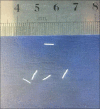Thermoanalytical characterization of clindamycin-loaded intravitreal implants prepared by hot melt extrusion
- PMID: 26322295
- PMCID: PMC4549919
- DOI: 10.4103/2277-9175.161563
Thermoanalytical characterization of clindamycin-loaded intravitreal implants prepared by hot melt extrusion
Abstract
Background: The aim of the present study was to evaluate a non-destructive fabrication method in for the development of sustained-release poly (L, D-lactic acid)-based biodegradable clindamycin phosphate implants for the treatment of ocular toxoplasmosis.
Materials and methods: The rod-shaped intravitreal implants with an average length of 5 mm and a diameter of 0.4 mm were evaluated for their physicochemical parameters. Scanning electron microscopy (SEM), differential scanning calorimetry (DSC), Fourier-transform infrared (FTIR), and nuclear magnetic resonance (1H NMR) studies were employed in order to study the characteristics of these formulations.
Results: Drug content uniformity test confirmed the uniformity in different implant batches. Furthermore, the DSC, FTIR, and 1H NMR studies proved that the fabrication process did not have any destructive effects either on the drug or on the polymer structures.
Conclusion: These studies showed that the developed sustained-release implants could be of interest for long-term sustained intraocular delivery of clindamycin, which can provide better patient compliance and also have good potential in terms of industrial feasibility.
Keywords: Clindamycin phosphate; D-lactic acid); intravitreal implant; melt extrusion; poly (L.
Conflict of interest statement
Figures







Similar articles
-
Manufacturing of Dexamethasone-Poly(d,l-Lactide-co-Glycolide) Implants Using Hot-Melt Extrusion: Within- and Between-Batch Product Performance Comparisons.J Ocul Pharmacol Ther. 2020 Jun;36(5):290-297. doi: 10.1089/jop.2019.0074. Epub 2020 Apr 24. J Ocul Pharmacol Ther. 2020. PMID: 32330403 Free PMC article.
-
Development and evaluation of raloxifene hydrochloride-loaded subdermal implants using hot-melt extrusion technology.Int J Pharm. 2022 Jun 25;622:121834. doi: 10.1016/j.ijpharm.2022.121834. Epub 2022 May 18. Int J Pharm. 2022. PMID: 35597391
-
Hot-Melt Extrusion-Based Dexamethasone-PLGA Implants: Physicochemical, Physicomechanical, and Surface Morphological Properties and In Vitro Release Corrected for Drug Degradation.Pharmaceutics. 2024 Jul 4;16(7):895. doi: 10.3390/pharmaceutics16070895. Pharmaceutics. 2024. PMID: 39065592 Free PMC article.
-
Design and development of intraocular polymeric implant systems for long-term controlled-release of clindamycin phosphate for toxoplasmic retinochoroiditis.Adv Biomed Res. 2015 Jan 30;4:32. doi: 10.4103/2277-9175.150426. eCollection 2015. Adv Biomed Res. 2015. PMID: 25709997 Free PMC article.
-
Polymeric Implants for the Treatment of Intraocular Eye Diseases: Trends in Biodegradable and Non-Biodegradable Materials.Pharmaceutics. 2021 May 12;13(5):701. doi: 10.3390/pharmaceutics13050701. Pharmaceutics. 2021. PMID: 34065798 Free PMC article. Review.
Cited by
-
Solid Polymeric Nanoparticles of Albendazole: Synthesis, Physico-Chemical Characterization and Biological Activity.Molecules. 2020 Nov 4;25(21):5130. doi: 10.3390/molecules25215130. Molecules. 2020. PMID: 33158183 Free PMC article.
-
Intraocular drug delivery systems for Diabetic retinopathy: Current and future prospective.Bioimpacts. 2024 May 19;15:30127. doi: 10.34172/bi.30127. eCollection 2025. Bioimpacts. 2024. PMID: 39963560 Free PMC article. Review.
-
Injectable Platelet-Rich Fibrin as a Drug Carrier Increases the Antibacterial Susceptibility of Antibiotic-Clindamycin Phosphate.Int J Mol Sci. 2022 Jul 3;23(13):7407. doi: 10.3390/ijms23137407. Int J Mol Sci. 2022. PMID: 35806408 Free PMC article.
-
Selective Delivery of Clindamycin Using a Combination of Bacterially Sensitive Microparticle and Separable Effervescent Microarray Patch on Bacteria Causing Diabetic Foot Infection.Pharm Res. 2024 May;41(5):967-982. doi: 10.1007/s11095-024-03697-z. Epub 2024 Apr 18. Pharm Res. 2024. PMID: 38637438
-
Investigation of Drug-Polymer Compatibility Using Chemometric-Assisted UV-Spectrophotometry.Pharmaceutics. 2017 Jan 16;9(1):7. doi: 10.3390/pharmaceutics9010007. Pharmaceutics. 2017. PMID: 28275214 Free PMC article.
References
-
- Bourges JL, Bloquel C, Thomas A, Froussart F, Bochot A, Azan F, et al. Intraocular implants for extended drug delivery: Therapeutic applications. Adv Drug Deliv Rev. 2006;58:1182–202. - PubMed
-
- Choonara YE, Pillay V, Danckwerts MP, Carmichael TR, du Toit LC. A review of implantable intravitreal drug delivery technologies for the treatment of posterior segment eye diseases. J Pharm Sci. 2010;99:2219–39. - PubMed
-
- Eljarrat-Binstock E, Pe’er J, Domb AJ. New techniques for drug delivery to the posterior eye segment. Pharm Res. 2010;27:530–43. - PubMed
-
- Del Amo EM, Urtti A. Current and future ophthalmic drug delivery systems. A shift to the posterior segment. Drug Discov Today. 2008;13:135–43. - PubMed
-
- Thrimawithana TR, Young S, Bunt CR, Green C, Alany RG. Drug delivery to the posterior segment of the eye. Drug Discov Today. 2011;16:270–7. - PubMed
LinkOut - more resources
Full Text Sources
Other Literature Sources

